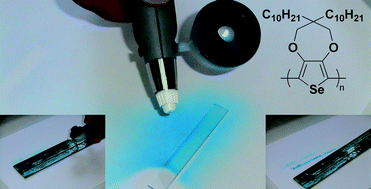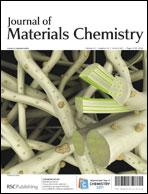The optical and electrochemical properties of a regioregular and soluble alkylenedioxyselenophene-based electrochromic polymer, namely poly(3,3-didecyl-3,4-dihydro-2H-selenopheno[3,4-b][1,4]dioxepine (PProDOS-C10), which is synthesized by electrochemical polymerization, are highlighted. It is noted that this unique polymer has a low band gap (1.58 eV) and is exceptionally stable under ambient atmospheric conditions. Polymer films retain 97% of their electroactivity after 40 000 cycles. The percentage transmittance of a PProDOS-C10 film was found to be 56.4% at 638 nm and 55.8% at 700 nm. Furthermore, this novel soluble PProDOS-C10polymer shows an electrochromic behavior: a color change from pure blue to a highly transparent state in a low switching time (1.0 s) during oxidation, with high coloration efficiencies (328 cm2C−1 at 638 nm and 319 cm2C−1 at 700 nm) when compared to its thiophene analogue.
You have access to this article
 Please wait while we load your content...
Something went wrong. Try again?
Please wait while we load your content...
Something went wrong. Try again?


 Please wait while we load your content...
Please wait while we load your content...